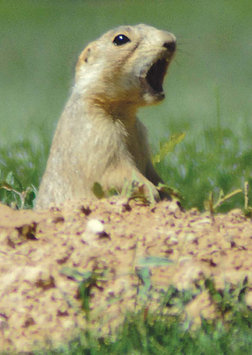U.S. Fish and Wildlife Service considers
endangered species act listing for critter
Danny Decker, a Cortez
farmer with 560 acres of hay, has an enemy
lurking in the fields.
That enemy is prairie dogs.
Decker is not alone. Local farmers,
ranchers, business owners and government
agencies grumble and groan when they see
this four-legged rodent pop its head out
of freshly-dug hole, and many people will
do almost anything to get rid of prairie
dogs.
The U.S. Fish and Wildlife Service
recently announced the Gunnison's prairie
dog, a species found only in the Four
Corners, will be reconsidered for the
endangered species list, giving the animal
that loves to dig up local land federal
protection.
"I think that is the worst thing they
can do," Decker said.
A prairie dog colony can ruin a crop of
hay, he said. The mounds they create will
get dust in the hay. One time, Decker's
tractor fell into a prairie dog hole and
broke an axle.
"It cost $2,500 to replace," he said.
"The prairie dogs do so much damage across
the country, (listing them) would be
devastating."
Even though Decker does his best to
control the population, the species still
thrives.
"It's a continual problem - all the
time," he said. "You are never going to
get rid of them."
PRAIRIE DOG PLAGUE
Forest Guardians, an environmental
group based in New Mexico, said the
Gunnison's prairie dogs are dramatically
decreasing. During the past 100 years,
areas occupied by the species has
decreased by 90 percent, according to the
group.
"The Gunnison's prairie dog desperately
needs federal protection if it is to be
spared from extinction," Con Slobodchikoff,
a prairie dog researcher, said in a
written statement. "With the devastating
impact of exotic plague, habitat
destruction, and rampant shooting and
poisoning, this species does not have the
luxury of time."
Research has shown sylvanic plague is
one of the Gunnison's prairie dog's
biggest killers, according to the National
Wildlife Federation. Mortality can exceed
99 percent.
Decker said prairie dogs on his land
caught the plague in 1995. They completely
disappeared and took several years to come
back.
He wishes that would happen again.
A report the National Wildlife
Federation commission in 2002 for the
status of both the white-tailed prairie
dog and the Gunnison's prairie dog pointed
out how important the prairie dog is to
other species, including the black-footed
ferret and burrowing owl.
Between 1999 and 2002, Montezuma County
had one of the highest counts of
Gunnison's prairie dogs in the state, just
behind Archuleta County with an estimated
15,978 acres of prairie dogs and Costilla
County with an estimated 14,948 acres,
according to a survey by the Colorado
Division of Wildlife, U.S. Forest Service
and U.S. Bureau of Land Management.
Montezuma County has an estimated 12,223
acres.
"They are everywhere," Decker said.
PARKS AND PRAIRIE DOGS
Chris Burkett, former Cortez Parks and
Recreation director for 30 years, said he
has had his fair share of battles with the
burrow-digging rodent, especially when the
city established Centennial Park and
Parque De Vida.
Both parks covered vacant lots that had
a fair amount of prairie dogs.
Burkett said the city has a permit to
kill prairie dogs and has tried several
methods, including gas, traps and smoke
bombs. Burkett said at one point they even
tried to use tractor exhaust to push them
out.
The city eventually won the turf war
against prairie dogs once the parks were
established. If the parks are kept
watered, the animals generally stay away.
"If you keep your ground irrigated,
they don't come in," Burkett said.
Burkett laughed about the animals being
added to the endangered species list.
"They don't seem endangered down here,"
he said.
If prairie dogs are added to the list,
it is still important to keep them off
city land, Burkett said.
"You can just imagine if someone
stepped in one (prairie dog hole) and
broke an ankle," Burkett said.
Reach Shannon Livick at shannonl@cortezjournal.com.


